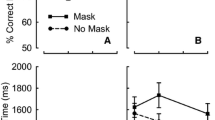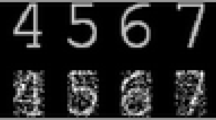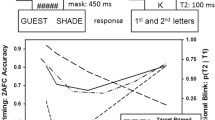Abstract
Identification of the second of two targets is impaired if it is presented less than about 500 ms after the first. Three models of this second-target deficit, known as attentional blink (AB), were compared:resource-depletion, bottleneck, and temporary loss of control (TLC). Five experiments, in which three sequential targets were inserted in a stream of distractors, showed that identification accuracy for the leading target depended on an attentional switch whose magnitude varied with distractor–target similarity. In contrast, accuracy for the trailing target depended on similarity between the target and the trailing mask. These results strongly suggest that the AB is not a unitary phenomenon. Resource-depletion was ruled out as a viable account. The effect of attentional switching was handled naturally by the TLC model, while bottleneck models offered the best account of the effect of backward masking.







Similar content being viewed by others
References
Chun, M. M., & Potter, M. C. (1995). A two-stage model for multiple target detection in rapid serial visual presentation. Journal of Experimental Psychology: Human Perception and Performance, 21, 109–127.
Di Lollo, V., Enns, J. T., & Rensink, R. A. (2000). Competition for consciousness among visual events: The psychophysics of reentrant visual processes. Journal of Experimental Psychology: General, 129, 481–507.
Di Lollo, V., Kawahara, J., Ghorashi, S. M. S., & Enns, J. T. (2005). The attentional blink: Resource limitation or temporary loss of control?Psychological Research, 69, 191–200.
Hellige, J. B., Walsh, D. A., Lawrence, V. W., & Prasse, M. (1979). Figural relationship effects and mechanisms of visual masking.Journal of Experimental Psychology: Human Perception and Performance, 5, 88–100.
Jolicoeur, P. & Dell’Acqua, R. (1998). The demonstration of short-term consolidation. Cognitive Psychology, 36, 138–202.
Kawahara, J.(2003). Mandatory processing of distractors: Another determining factor for the attentional blink. Japanese Psychological Research, 45, 140–151. (in English).
Kawahara, J., Zuvic, S. M., Enns, J. T., & Di Lollo, V. (2003). Task switching mediates the attentional blink even without backward masking. Perception & Psychophysics, 65, 339–351.
Maki, W. S., Bussard, G., Lopez, K., & Digby, B. (2003). Sources of interference in the attentional blink: target-distractor similarity revisited. Perception & Psychophysics, 65, 188–201.
Pashler, H. E. (1998). The psychology of attention. Cambridge, Massachusetts: MIT Press.
Ryan, T. (1960). Significance test for multiple comparisons of proportions, variances, and other statistics. Psychological Bulletin, 57, 318–328.
Shapiro, K. L., Raymond, J. E., & Arnell, K. M. (1994). Attention to visual pattern information produces the attentional blink in RSVP. Journal of Experimental Psychology: Human Perception and Performance, 20, 357–371.
Sperling, G.,& Weichselgartner, E. (1995). Episodic theory of the dynamics of spatial attention. Psychological Review, 102, 503–532.
Visser, T. A. W., Bischof, W. F., & Di Lollo, V. (2005). Rapid serial visual distraction: Task-irrelevant items can produce an attentional blink. Perception & Psychophysics (in press).
Ward, R., Duncan, J., & Shapiro, K. (1996). The slow time-course of visual attention. Cognitive Psychology, 30, 79–109.
Author information
Authors and Affiliations
Corresponding author
Rights and permissions
About this article
Cite this article
Kawahara, Ji., Enns, J.T. & Lollo, V.D. The attentional blink is not a unitary phenomenon. Psychological Research 70, 405–413 (2006). https://doi.org/10.1007/s00426-005-0007-5
Received:
Accepted:
Published:
Issue Date:
DOI: https://doi.org/10.1007/s00426-005-0007-5




